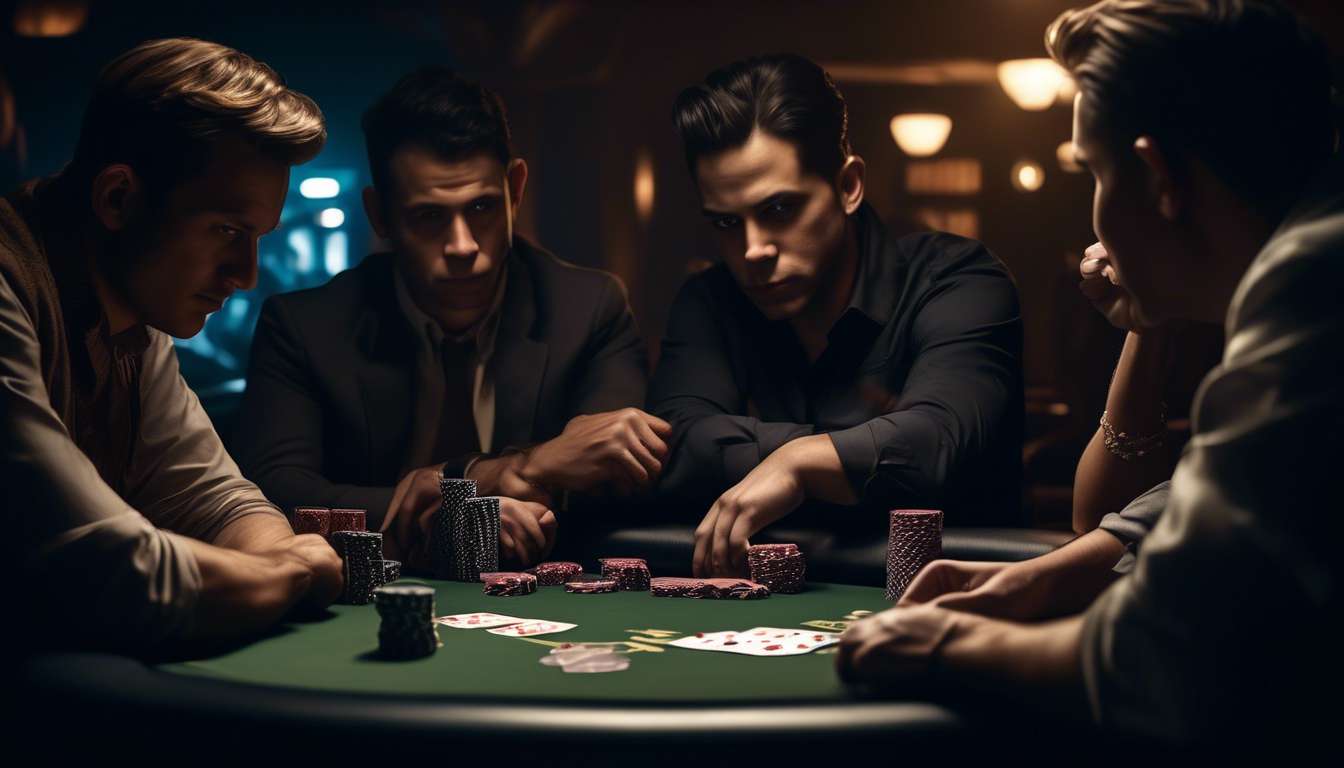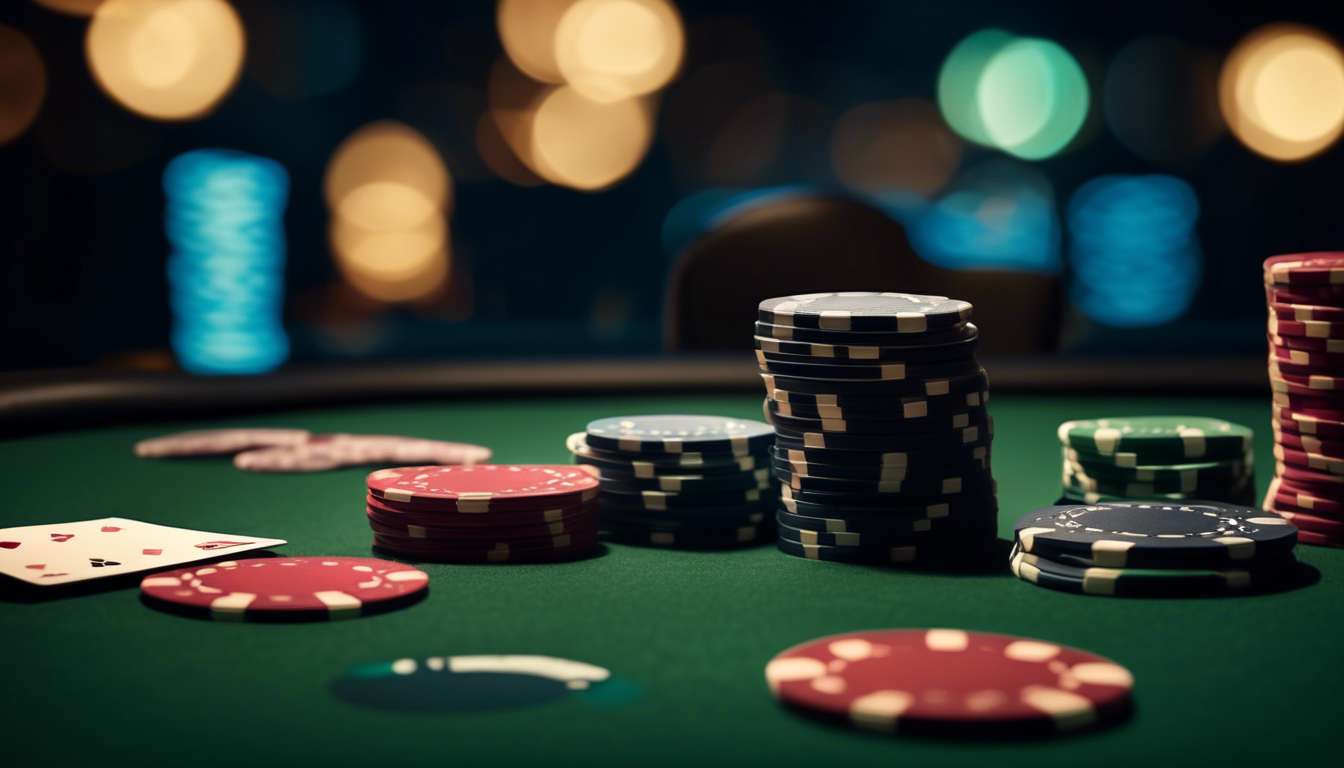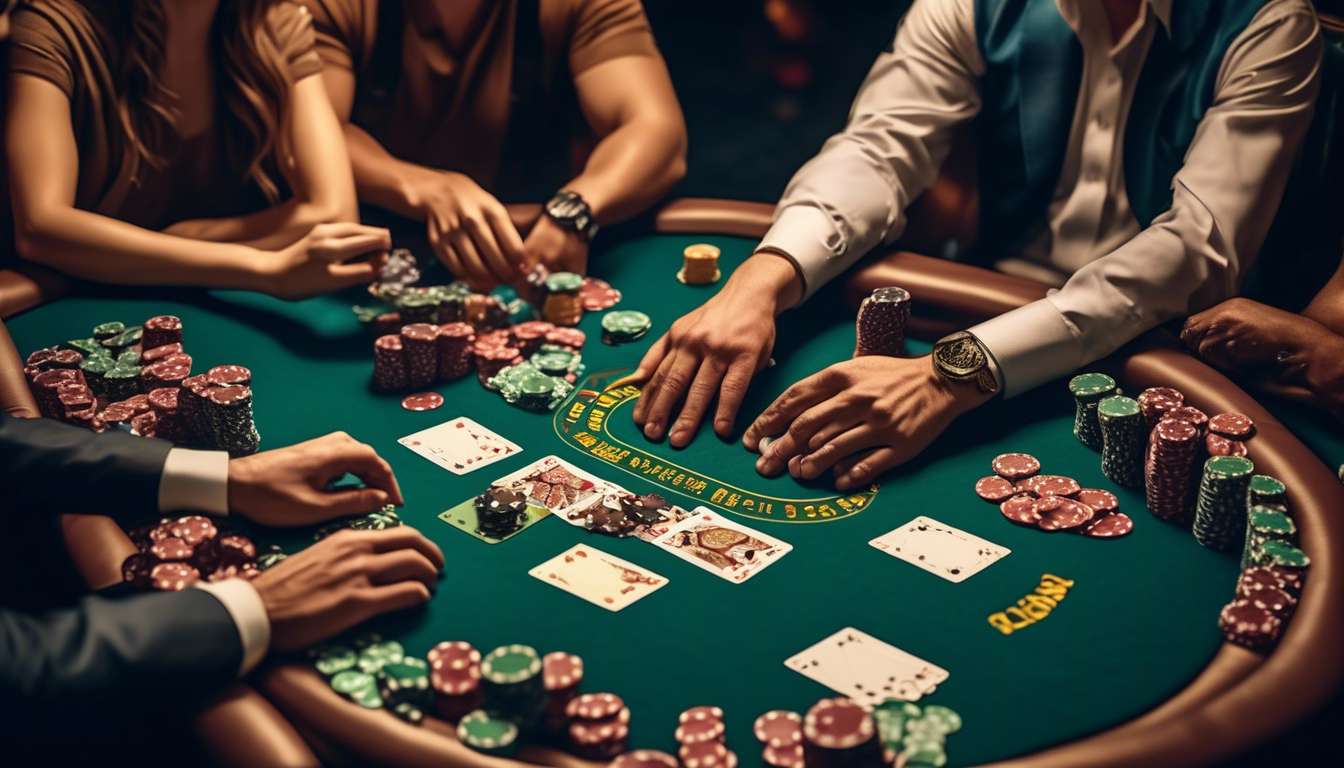In the high-stakes world of poker, we often find ourselves sitting across the table from opponents whose faces are as inscrutable as stone. Yet, beneath the surface, subtle signals and unconscious gestures can reveal volumes about their hand.
In this ultimate guide, we delve into the art and science of reading poker tells and body language, equipping us with the skills to decipher these hidden clues.
Key Areas of Focus:
-
Eye Movements
- Observe where and how often opponents look.
- Note any changes in focus or direction that might indicate nervousness or confidence.
-
Facial Expressions
- Pay attention to smiles, frowns, or any other facial movements.
- Watch for consistency or sudden changes that might suggest an attempt to bluff.
-
Micro-Expressions
- Identify fleeting expressions that can reveal true emotions.
- Practice recognizing these quick signals to gain an advantage.
By honing our observational skills and understanding the psychology behind these tells, we can elevate our game to new heights. Whether we’re seasoned players or newcomers to the felt, this guide promises to sharpen our instincts and refine our strategies, transforming the way we interpret the silent language of the poker table.
Let’s embark on this journey to mastery together.
Eye Movements
Eye Movements in Poker
Eye movements can reveal a lot about a player’s thoughts and intentions during a poker game. As we sit around the table, trying to decipher each other’s strategies, eye contact becomes a crucial element. In poker, locking eyes can signify confidence or an attempt to intimidate.
It’s not just about where we’re looking, but how we’re looking:
- Quick shifts in gaze or avoiding eye contact might suggest nervousness or a bluff.
Micro-Expressions
Pay attention to subtle micro-expressions that accompany eye movements:
- A slight squint or a raised eyebrow can betray uncertainty or surprise.
These cues add another layer to our understanding of body language.
Collective Skill Enhancement
By honing our ability to read eye movements, we:
- Strengthen our bond as a group of observant players.
- Enhance our collective skill.
- Deepen our connection to the game and each other.
Together, we can learn to pick up on these cues, making us more adept players.
Facial Expressions
Facial expressions, often fleeting yet profoundly revealing, offer us a window into a player’s true emotions and intentions at the poker table. Our community thrives on understanding these subtle cues, as catching a glimpse of a player’s genuine feelings can mean the difference between winning and losing.
By focusing on eye contact, we’re able to discern confidence or anxiety.
- A player holding a strong hand might maintain steady eye contact.
- A bluff could lead to avoidance or rapid blinking.
Our ability to read body language becomes richer when we incorporate facial expressions. For instance, a slight twitch or the tightening of lips might indicate uncertainty or stress. Though these micro-expressions are quick, they’re invaluable to us who seek to connect with fellow players on a deeper level.
By honing our skills and noticing these nuances, we not only improve our game but also strengthen the camaraderie shared at the table. Together, let’s master this art and enhance our poker experience.
Micro-Expressions
In the high-stakes world of poker, our ability to recognize and interpret micro-expressions can be the key to gaining a strategic edge over opponents. These fleeting facial expressions, often lasting just a fraction of a second, reveal genuine emotions that players might try to hide.
As a community of poker enthusiasts, understanding these subtle cues strengthens our bond and enhances our collective gameplay.
Maintaining eye contact is crucial as it allows us to notice micro-expressions more effectively. When we focus on our opponents’ eyes, we can catch those brief, involuntary expressions that might indicate:
- Stress
- Confidence
- Deception
Even the slightest twitch or furrow can be a telltale sign of their hand’s strength or weakness.
Body language, combined with micro-expressions, provides a comprehensive picture of our opponents’ intentions. By honing our skills in reading these signals, we not only improve our individual games but also contribute to a shared experience of strategic mastery.
Together, we can elevate our poker prowess.
Hand Gestures
Hand gestures can reveal crucial information about our opponents’ confidence levels and intentions during a poker game. As part of a community striving to read these subtle cues, we recognize that every flick of the wrist or tap of the fingers adds a layer to the intricate tapestry of body language.
When combined with keen eye contact and the swift flicker of micro-expressions, hand gestures offer us a deeper understanding of what our fellow players might be concealing.
Key Observations:
- Shaky hands can betray nerves.
- Steady, deliberate movements suggest confidence.
- A player who suddenly hides their hands might be trying to mask anxiety or uncertainty.
- Open palms can indicate honesty or transparency.
In our shared quest to master the art of reading poker tells, paying attention to these gestures helps us bond as we collectively decipher the unspoken language at the table.
By honing in on these details, we enhance our ability to connect and compete effectively.
Posture and Body Position
Our posture and body position at the poker table speak volumes about our level of confidence and strategy. As part of this tight-knit poker community, we know that subtle shifts in posture can indicate a lot.
- Leaning forward often signals engagement or strength.
- Leaning back might suggest relaxation or even bluffing.
Our body language, including how we hold ourselves, sends signals that others are keenly observing.
Eye contact plays a crucial role too.
- Maintaining steady eye contact can project confidence and control.
- Avoiding eye contact might reveal insecurity or an attempt to hide something.
We’ve all noticed those quick glances and micro-expressions that flit across a player’s face, revealing emotions before they can mask them.
By consciously managing our posture and body position, we not only boost our own confidence but also gain insights into our opponents. Together, we understand that mastering these tells enhances our camaraderie and shared success at the table.
Verbal Cues
Verbal cues at the poker table, such as tone and choice of words, often provide critical insights into a player’s hand and intentions. In the poker community, understanding these subtleties can mean the difference between a winning hand and a costly mistake.
When players speak, we should pay close attention to their tone:
- Are they confident?
- Is there a hint of hesitation?
These subtleties, combined with body language, can reveal more than they intend.
Eye contact during conversation is another crucial aspect.
- Genuine glances can imply truthfulness.
- Avoiding our gaze might suggest deception.
We’ve also noticed that micro-expressions—those fleeting, involuntary facial movements—can betray a player’s true feelings despite their verbal claims. Recognizing these tells can build our sense of belonging in the poker world, linking us with other experts who appreciate the game’s psychological depth.
By honing our skills in interpreting verbal cues, we enhance our ability to read and connect with others at the table.
Timing and Speed
The timing and speed of a player’s actions at the poker table can offer valuable clues about their hand strength and strategy.
- Quick decisions might suggest a player is confident in their hand.
- Hesitation could indicate doubt or bluffing.
We should pay close attention to these patterns, as they often reveal more than words or chips.
In our quest to read people, let’s not overlook the importance of eye contact. It’s a window into their confidence and resolve.
- A player who maintains steady eye contact might be challenging us.
- Avoiding our gaze could signal discomfort or uncertainty.
Alongside this, micro-expressions provide fleeting insights into a player’s true feelings. These subtle cues, coupled with body language, shape the narrative we’re trying to decipher.
As a community of players, understanding these nuances enriches our game and bonds us through shared knowledge. By mastering timing and speed, we connect deeper with others at the table, enhancing our collective experience.
Cluster Analysis
In cluster analysis, we group players based on similar behavioral patterns to enhance our understanding of their strategies and tendencies. By observing eye contact, micro-expressions, and body language, we can categorize players into clusters, creating a shared insight that strengthens our poker community.
We know the feeling of wanting to belong, and understanding these clusters helps us connect and compete more effectively.
Key Observations:
-
Eye Contact:
- Maintaining eye contact might signal confidence.
- Avoiding eye contact could suggest uncertainty or deception.
-
Micro-expressions:
- A fleeting smile or raised eyebrow can reveal emotions a player tries to hide.
-
Body Language:
- Leaning forward might indicate interest or confidence.
- Crossing arms could suggest defensiveness or a weak hand.
By noting these patterns, we align ourselves with others who see the hidden cues.
As we analyze these behaviors together, we build a collective knowledge base, making us sharper and more attuned to the game’s subtleties.
We’re not just players; we’re a community of keen observers.
How can the environment or setting of a poker game influence the accuracy of reading poker tells and body language?
In poker, the environment plays a crucial role in reading tells accurately.
Factors that affect our ability to pick up on subtle cues include:
- Lighting: A dimly lit room might make it harder to spot facial expressions.
- Noise level: A noisy setting could mask verbal tells.
- Seating arrangements: The way players are seated can influence our line of sight and ability to observe their behavior.
Being mindful of these environmental factors can help us improve our reading skills and make better decisions at the poker table.
What role does cultural background play in interpreting poker tells and body language accurately?
Our cultural background shapes how we interpret poker tells and body language. It influences our understanding of gestures, expressions, and behaviors.
When diverse backgrounds come together at the poker table, it adds a layer of complexity to reading opponents accurately. By being aware of these cultural differences, we can improve our abilities to decipher signals and make more informed decisions during the game.
Benefits of cultural awareness in poker:
-
Improved Interpretation: Understanding cultural nuances helps in accurately interpreting body language and gestures.
-
Informed Decision-Making: Awareness of these differences leads to better decision-making during the game.
-
Enhanced Skills: Embracing diversity enriches our poker experience and enhances our skills.
By embracing this diversity, players can gain a competitive edge and enjoy a more enriching poker experience.
How can a player’s history and experience level impact the reliability of their tells?
Our history and experience level heavily influence how reliable our poker tells are.
Beginners might be more obvious in their behaviors, while seasoned players can mask their true intentions more effectively.
Understanding our own patterns and tendencies is crucial to improving our poker game. By recognizing how our past plays a role in our tells, we can work on refining our skills and becoming more unpredictable at the poker table.
Conclusion
So, next time you’re at the poker table, remember to keep a keen eye on your opponents.
Watch for those subtle hints in their:
- Eye movements
- Facial expressions
- Hand gestures
- Body language
Pay attention to:
- How they speak
- The timing of their actions
By mastering the art of reading poker tells, you’ll have a strategic edge that can lead you to victory.
Happy playing!




